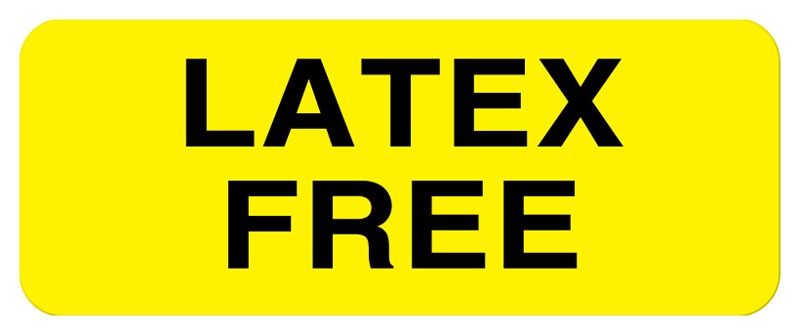Allergies create healthcare process challenges. Often a patient won’t know that they have an allergy. They may also contract an allergy when exposed to a medication or substances for the first time. However, when allergies are known, avoiding allergens that cause the problem is the best defense. Communicating information to ensure proper patient care is crucial.
Here are common allergy challenges that all healthcare facilities face and how allergy labels can help mitigate contact and the subsequent problems.
Latex Allergies
Latex is a common allergy found in healthcare settings because over time, exposure to latex increases the risk you’ll contract the allergy. Contained in many medical and dental supplies, latex is found in disposable gloves, dental dams, dressings, bandages and more. In fact, it could even be contained in the balloons a well wishing family member brought from the gift shop! In addition to patients, healthcare workers who wear latex gloves are more likely to develop the allergy.
Latex Allergy Avoidance
Both latex free and latex precaution labels alert medical professionals about patients with the allergy. They also bring awareness to the staff workers who need to be aware of latex for their own safety.
Another way to avoid latex is through allergy labels or other similar items used in a healthcare operation. Latex is a natural property of the rubber based adhesives used in label manufacturing. Look for companies like UAL that use latex free synthetic based adhesives.
Food Allergies
Food service operations prepare food for hundreds of patients with no problems. Unfortunately, nearly 2,000,000 people have food allergies. So for those patients, It’s essential to communicate appropriate instructions.
Food Allergy Avoidance
Although any food can create an adverse reaction, less than 10 types of food represent 90% of allergic reactions. Making healthcare professionals aware of patients with allergies and making patients aware of the food items that contain known allergens is the best form of food allergy prevention.
An allergy warning label
Identifies the specific food group to prohibit. If a patient's food allergy falls outside of those common items, you can simply write in the food group to avoid.
Other warning labels like the allergen warning labels
Bring attention to foods a patient may need to stay away from.
Medication Allergies
Although all medications have the potential to cause side effects, only 5 - 10% of reactions are due to allergies. Communicating the risk in patient charts and files will warn staff members when medication presents an allergic risk.
Medication Allergy Avoidance
Medication allergy alert labels make it easy to identify medications that put patients at risk.
Or signal that the patient has no known allergies.
Contrast allergies may also present problems for certain patients. Allergy labels designed for mammograms and other contrast allergies bring awareness before contrast agents are used.
In addition, during the admission process or whenever wristbands are required, use latex free products. For example, all United Ad Label wristbands, both plastic and tyvek style, are latex free. Plus, wristbands are an ideal way to alert medical professionals of patient allergies, regardless of the variety.
Visibility Improves Outcome
Allergy labels that are highly visible and contain both bright colors and bold lettering make warnings stand out. These simple steps help medical professionals take proper steps to avoid allergy challenges.
To learn more about how United Ad Label can assist your healthcare organization in mitigating common allergy challenges, contact us or browse our selection of allergy labels. We also offer custom allergy label solutions if our stock options do not meet your needs.
